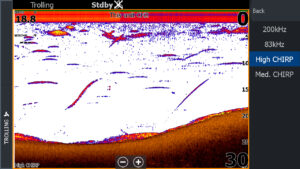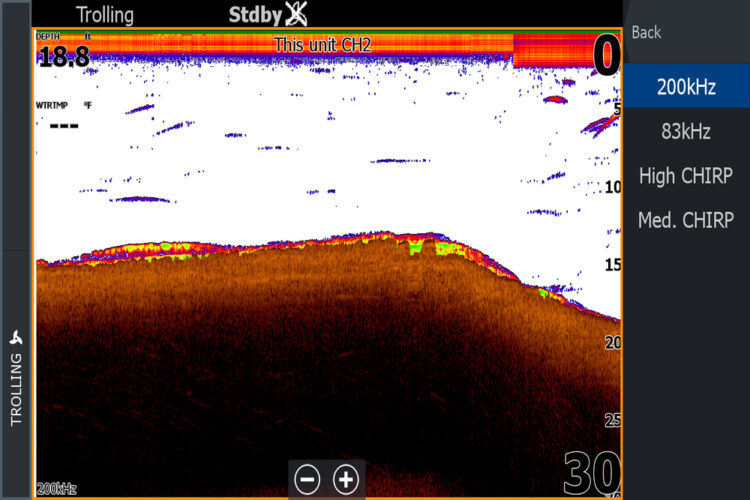Traditional 2D sonar pings a single echo and is available in 200kHz or 83kHz. (Brad Wiegmann Photo)
Is Traditional 2D and CHIRP Sonar Obsolete?
by Brad Wiegmann
Do you need traditional 2D and CHIRP sonar? Is traditional 2D sonar and CHIRP obsolete? It seems like the surge of anglers purchasing units just so they can have live-imaging sonar is over staggering and the trend is new sonar purchases are now based on getting a new sonar unit just for getting LIS in the boat.
Traditional 2D sonar transmitting from a fish finder is a single frequency being pinged. These frequencies are low, medium, and high. Low (50kHz) is mostly used in water depths of greater than 300 feet with a wide cone of 27 degrees commonly used in offshore fishing. Freshwater anglers mostly use medium (83kHz) with a medium-size 20-degree cone and high (200kHz) with a narrow 13-degree cone.
CHIRP (Compressed High Intensity Radar Pulse) on the other hand sends out numerous sonar pulses with a combination of different pulses. Similar to traditional 2D sonar, CHIRP sonar comes in low, medium, and high frequencies. Again low CHIRP is for deeper water situations while freshwater anglers and using medium CHIRP (95-155kHz) with a cone size of 16 to 24 degrees or high CHIRP (150-250kHz) with 11 to 16 degrees. Note that CHIRP frequencies and cone sizes vary according to the electronics manufacturer.
When CHIRP sonar came out anglers predicted that it would make traditional 2D sonar obsolete, but it didn’t. The low cost of traditional 2D sonar makes it affordable to have in every fish finder. When down imaging came out again it was predicted to make CHIRP sonar obsolete, but again it didn’t. CHIRP sonar is economically more affordable than down imaging.
Do you see the trend here? As new sonar technology is released the older sonar technology becomes more affordable, but marine electronics companies like Lowrance, Garmin, Humminbird, and Raymarine continue to include the older technology. The cost of fish finders is based on the unit and transducer that have increased in sizes and technology advances.

The ideal solution for the angler is to utilize having multiple panels open with different sonar options for their unit. The number of panels and options for panels differ between marine electronics companies’ fish finders. If an angler has multiple units different frequencies should be used to eliminate crosstalk between the units.
Is traditional 2D sonar and CHIRP sonar obsolete? Absolutely not! Live imaging sonar (LIS) currently is not designed to cover vast areas of water quickly. By quickly we are talking at idle speed or even faster. The good news is fish finders with LIS capabilities generally come with traditional 2D sonar or CHIRP sonar.



